

Palaeontological articles - Part 12. Are we all Asian Migrants?
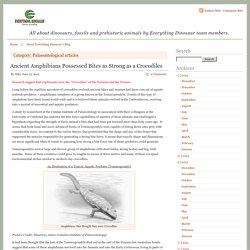
For many years, one specialist branch of the science of palaeontology, those scientists who have been studying the evolution of the primates (palaeoprimatologists) have puzzled over the exact origins of these creatures, a branch of which gave rise to the Hominins and ultimately our own species H. sapiens. Although the fossil record of early Cenozoic (Palaeogene) primates is exceptionally poor, a number of hypotheses had been put forward that supported an African origin for what is termed the Anthropoids (monkeys, apes and ultimately Hominins).
However, recent fossil finds, most notably in China had began to challenge these theories. The Aquatic Ape Hypothesis. You may have noticed some coverage in the press recently about the Aquatic Ape Hypothesis (AAH), sparked by a conference on the topic due to be held in May.

If you’re not familiar with the AAH it basically suggests that human ancestors passed through a semiaquatic stage which provided the selective pressure that has led to the differences seen between humans and other primates. Some people call it the Aquatic Ape Theory, but it lacks the necessary scientific support to be considered a theory so it remains a hypothesis [see comments for discussion of the terminology]. The idea was first suggested by pathologist Max Westenhöfer in 1942 and the first line of evidence in support of the hypothesis was proposed by marine biologist Alister Hardy in 1960. Hardy noted that subcutaneous fat is unusual in terrestrial mammals and is normally associated with marine mammals – raising the very good question ‘why do humans have subcutaneous fat?’ The Improbable Primate: How Water Shaped Human Evolution - Clive Finlayson. Aquatic Ape Theory. Aquatic Ape Hypothesis Paints a Different Picture of Human Evolution.
The aquatic ape hypothesis (AAH) proposes that our evolutionary ancestors, at some point, adapted to a semi-aquatic existence.

This challenges the consensus view that our ancestors left an arboreal habitat and continued to evolve in the terrestrial habitat of the African savannah. One of the most passionate proponents of the AAH is the writer Elaine Morgan. She details the hypothesis in her book The Aquatic Ape Hypothesis (1999) as well as in this more recent TED talk. Morgan was frustrated at how a male-centred picture of human evolution was being popularised. According to this view, the reason why our ancestors lost their hair was because male hunters needed to sweat while chasing game. Aquatic Ape - The Theory Evolves. Photo Credit – Marc Verhaegen Those of you who read my post, Bipedal – The Aquatic Ape Theory, might be interested to learn of this guest blog on Scienceblogs by Marc Verhaegen.
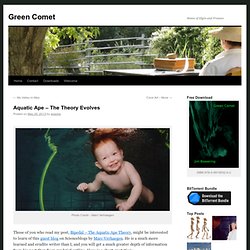
He is a much more learned and erudite writer than I, and you will get a much greater depth of information from his post than from my brief outline. Here is a short quotation: “It is often assumed that Alister Hardy’s and Elaine Morgan’s aquatic ape theory (AAT) suggests that more than 5 Ma (million years ago) there was a semi-aquatic phase in our past (explaining e.g. human fur loss, fatness and upright bipedalism), which was followed by a savanna phase on the African plains. In 2011, AAT proponents published an eBook, ‘Was Man more aquatic in the past?’ He was kind enough to comment on my post, and you can see that at the link above. King of the swimmers - aquatic apes prefer the breaststroke. Elaine Morgan. The Aquatic Ape (homo sapiens)?
Did our ancestors inhabit aquatic environments?

Consider the ‘aquatic ape hypothesis’. On March 5, 1960, professionally renowned and knighted marine biologist Alister Hardy delivered a speech proclaiming that humans evolved in an aquatic environment. Stable isotope analyses of tooth enamel carbonate of large herbivores from the Tugen Hills deposits: Palaeoenvironmental context of the earliest Kenyan hominids.
Hand before foot? Cortical somatotopy suggests manual dexterity is primitive and evolved independently of bipedalism. 1.
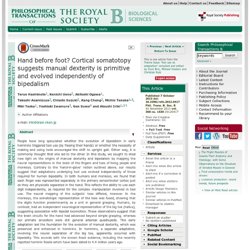
Introduction With the advent of genome-wide molecular studies [1,2], chimpanzees have been shown to be genetically the most similar, and phylogenetically closest, to humans (and equally so is the bonobo). The early human ancestral lineage(s) has, therefore, commonly been evaluated with respect to the extant chimpanzee. Telling Tales in Proto-Indo-European. (iStockphoto) By the 19th century, linguists knew that all modern Indo-European languages descended from a single tongue.

Called Proto-Indo-European, or PIE, it was spoken by a people who lived from roughly 4500 to 2500 B.C., and left no written texts. The question became, what did PIE sound like? In 1868, German linguist August Schleicher used reconstructed Proto-Indo-European vocabulary to create a fable in order to hear some approximation of PIE. Proximal metatarsal articular surface shape and the evolution of a rigid lateral foot in hominins. Human Evolution: The Origin of Tool Use. Editor's Note: This is Part 8 in a 10-part LiveScience series on the origin, evolution and future of the human species and the mysteries that remain to be solved.
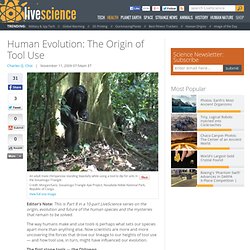
The way humans make and use tools is perhaps what sets our species apart more than anything else. Now scientists are more and more uncovering the forces that drove our lineage to our heights of tool use — and how tool use, in turn, might have influenced our evolution. The first stone tools — the Oldowan The ability to make and use tools dates back millions of years in our family tree.
Chimpanzees, our closest living relatives, can on their own devise spear-like weapons for hunting and create specialized tool kits for foraging ants, suggesting our family tree may have possessed wooden tools since the ancestors of humans and chimps diverged some 4 million years ago. Ancient Elephants Grazed Before They Had Teeth for It.
Ancient elephants switched from eating primarily leaves and shrubs to feeding on grass several million years before their teeth were fully adapted for grazing, according to a new study.
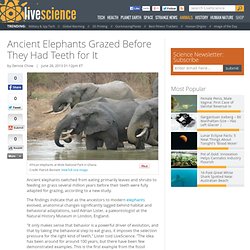
The findings indicate that as the ancestors to modern elephants evolved, anatomical changes significantly lagged behind habitat and behavioral adaptations, said Adrian Lister, a paleontologist at the Natural History Museum in London, England. "It only makes sense that behavior is a powerful driver of evolution, and that by taking the behavioral step to eat grass, it imposes the selection pressure for the right kind of teeth," Lister told LiveScience. "The idea has been around for around 100 years, but there have been few demonstrated examples. This is the first example from the fossil record. " About 10 million years ago, during a time period known as the Miocene epoch, the east African climate became dryer and cooler, prompting the gradual spread of grasslands over areas that were once heavily forested. University of Liverpool - stream.liv.ac.uk - Video and audio streaming & sharing.
University of Liverpool - stream.liv.ac.uk - Video and audio streaming & sharing. Experts Pour Cold Water on David Attenborough 'Aquatic Ape' Claims. The theory holds that humans marine life led humans to gain particular traits Sir David Attenborough has been derided as "irrelevant" after adding his backing to a controversial theory that humans evolved partly in water.

Sir David told a conference in London that the aquatic ape hypothesis "made more sense" than the conventional savannah narrative accepted by the scientific mainstream. The aquatic ape theory holds that humans developed large brains and a two-footed gait due to spending large amounts of time in the water. Sir David said there were serious problems with the conventional hypothesis, while the aquatic theory provided further incentives to preserve marine life. "Gathering molluscs is far easier than chasing elephants and wildebeests across the savannah," he said. But scientists immediately rounded on the TV naturalist, saying his theory was not backed up by evidence. "Because the idea 'makes sense' to them, the data are irrelevant. Our aquatic ape ancestry. Elaine Morgan and the Aquatic Ape. The cover of Elaine Morgan's 1972 The Descent of Woman. Source: Erika Lorraine Milam.
Attenborough under attack over theory of aquatic ape. Did humans come from the seas instead of the trees? Much-derided theory of evolution about aquatic apes is debated in London - Science - News. The last time this question was asked, at a conference in 1992, there was much scoffing and ridicule. Other academics sneered and Bernard Levin wrote a full-page article lampooning the idea in a national newspaper.
This week’s conference, Human Evolution Past, Present and Future – Anthropological, Medical and Nutritional Considerations, at the Grange St Paul’s Hotel, has also already been the subject of much derision. Followers of the conventional and overwhelmingly accepted belief that our ancestors were very much land-based are launching a parody campaign online to argue we evolved from “space monkeys”. Aquatic Ape Theory. The evolutionary history of the hominin hand since the last common ancestor of Pan and Homo - Tocheri - 2008 - Journal of Anatomy.
Using parsimony and a cladogram based on the current consensus hominid phylogeny, it is reasonable to infer many features that probably characterized the hand of the Pan - Homo LCA ( Figs 2, 3 ; Tables 1, 2 ). Because there is sufficient fossil and comparative evidence for these 17 features, the likely conditions present at particular nodes within the hominin clade can also be reasonably resolved. The hand of the Pan - Homo LCA ( Figs 2, 4 , Node 4) most likely resembled that of an extant African ape overall, or at the very least it likely shared most, if not all, of the characteristics that are symplesiomorphic among the extant great apes (all except f because it is shared only among African apes and modern humans) ( Fig. 3 ; Table 1 ). Thus, we have clearly stated our working hypothesis against which we now interpret the fossil evidence. 4,300-Year-old chimpanzee sites and the origins of percussive stone technology. Author Affiliations Edited by Ofer Bar-Yosef, Harvard University, Cambridge, MA, and approved December 7, 2006 (received for review September 8, 2006) Abstract.
Chimps Shown Using Not Just a Tool but a "Tool Kit" Bijal Trivedi for National Geographic News October 6, 2004 Anyone who has tried to replace a punctured tire or fix a leaky faucet knows the importance of having the right tool for the job. Chimpanzees, it turns out, are also very particular about their tool choice, especially when it comes to digging into termite mounds to get a tasty snack. Chimps Use "Spears" to Hunt Mammals, Study Says. February 22, 2007 For the first time, great apes have been observed making and using tools to hunt mammals, according to a new study. The past is a guide to the future? Comparing Middle Pliocene vegetation with predicted biome distributions for the twenty-first century. + Author Affiliations Author for correspondence ( usa@bas.ac.uk ) Abstract During the Middle Pliocene, the Earth experienced greater global warmth compared with today, coupled with higher atmospheric CO 2 concentrations.
Sago-Type Palms Were an Important Plant Food Prior to Rice in Southern Subtropical China. Brains. Bigger Brains: Complex Brains for a Complex World Endocasts of Homo erectus (left) and Homo sapiens (right) illustrate rapid increase in brain size. As early humans faced new environmental challenges and evolved bigger bodies, they evolved larger and more complex brains. Large, complex brains can process and store a lot of information. Aquatic Ape Theory: Another nail in the coffin. I just want to say that Huxley is pretty bad at swimming. I quickly add, for a 3 year old human, he’s pretty darn good at it. Amanda’s family is very aquatic, as tends to happen when everyone spends several weeks per year (or longer) on the edge of a lake.
They can all ski really well, they can all swim really well, etc. etc. So, very soon after Huxley was born, his grandfather started to bring him to age-appropriate swimming lessons. Ancient hominids may have left the trees, but we never abandoned them. Oh sighence! I'd say it's pretty obvious that we still have these qualities. Most people just don't pursue or use that stuff.
The Darwin-Wallace mystery solved: Darwin vindicated from accusations of deceit. A National University of Singapore. study has traced historical shipping records and vindicated Darwin from accusations of deceit. 1330400312_ftp.pdf;jsessionid=7A61CC7CC04255BB93D08DC4003CB4EC. Before Farming: the archaeology and anthropology of hunter-gatherers.
Ref: Before Farming 2012/1 article 1. David Blaine: How I held my breath for 17 min. Marine prey processed with stone tools b... [Am J Phys Anthropol. 2012. Evidence to Suggest That Teeth Act as Human Ornament Displays Signalling Mate Quality. Ornament displays seen in animals convey information about genetic quality, developmental history and current disease state to both prospective sexual partners and potential rivals. In this context, showing of teeth through smiles etc is a characteristic feature of human social interaction. Tooth development is influenced by genetic and environmental factors. Knuckle-walking and the evolution of hominoid hands - Tuttle - 2005 - American Journal of Physical Anthropology. Striding Bipedalism.
Type C Viral Antigens in Man. I. Antigens Related to Endogenous Primate Virus in Human Tumors. Malaria: A vector infecting both apes and humans. The Rocks Remain: Spears and eels: aquatic archaeological contexts in human evolution. Genes show one big European family. Bentham Science Publishers. Revising Darwin’s sinking-island theory. Human frontal lobes are not relatively large.
Journal of Human Evolution - A comparison of proximal humeral cancellous bone of great apes and humans.